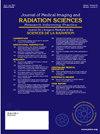Radiography students’ learning of plain X-ray examinations in clinical practice: An ethnographic study
IF 1.3
Q3 RADIOLOGY, NUCLEAR MEDICINE & MEDICAL IMAGING
Journal of Medical Imaging and Radiation Sciences
Pub Date : 2025-02-27
DOI:10.1016/j.jmir.2024.101758
引用次数: 0
Abstract
Introduction
Learning of plain x-ray examinations in clinical practice is the core element of becoming a professional in diagnostic radiography. Learning in clinical practice is situated in an authentic socio-cultural context promoting students’ learning from legitimate peripheral participation to full participation. The purpose of this study was to describe and understand radiography students’ learning of plain X-ray examinations in clinical practice.
Methods
The data consisted of observations, learning diaries and interviews of 17 radiography students and the researcher's own field notes regarding students’ clinical practice of plain X-ray examinations. Learning was studied from the perspective of interpretive ethnography. Data were analyzed by the constant comparative method.
Results
In clinical practice, radiography students’ learning was governed by a learning culture requiring the ability to interpret and adapt to the prevailing learning styles of the clinical practice contexts. The learning styles were: 1) learning towards expertise through collaboration, 2) learning actively through student's solo work and 3) learning by working in the background and following instructions. In these learning styles, the extent and depth of the learning content, patient care and imaging varied. Learning methods, learning in cooperation, students’ solo working and learning under radiographers’ changeable guidance differed as well. Students’ learning was impacted by the factors radiographer's supervision and student's learning space. According to students’ own evaluation, the learning outcomes regarding theory-practice connection were achieved to a variable extent.
Conclusion
Learning culture provided variable opportunities for the socio-cultural context to promote students’ learning in clinical practice. The results can be applied when developing and implementing radiography students’ clinical practice. Further research could focus on strengthening the curriculum towards cooperative learning.
求助全文
约1分钟内获得全文
求助全文
来源期刊

Journal of Medical Imaging and Radiation Sciences
RADIOLOGY, NUCLEAR MEDICINE & MEDICAL IMAGING-
CiteScore
2.30
自引率
11.10%
发文量
231
审稿时长
53 days
期刊介绍:
Journal of Medical Imaging and Radiation Sciences is the official peer-reviewed journal of the Canadian Association of Medical Radiation Technologists. This journal is published four times a year and is circulated to approximately 11,000 medical radiation technologists, libraries and radiology departments throughout Canada, the United States and overseas. The Journal publishes articles on recent research, new technology and techniques, professional practices, technologists viewpoints as well as relevant book reviews.
 求助内容:
求助内容: 应助结果提醒方式:
应助结果提醒方式:


